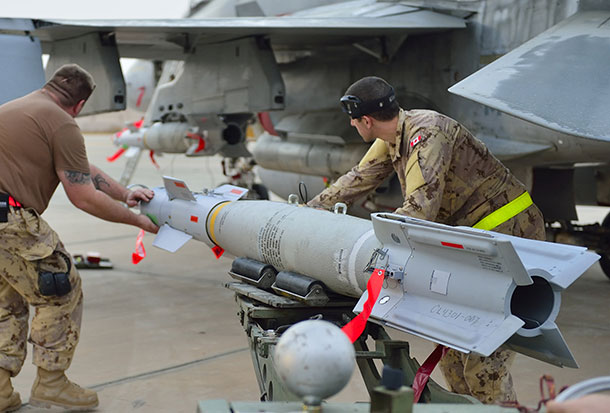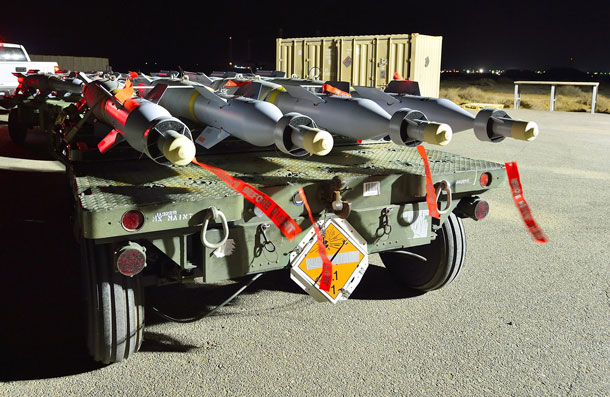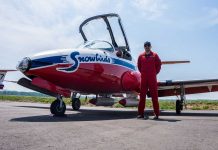
TAMPA – INTERNATIONAL – U.S. military forces continued to attack Islamic State of Iraq and the Levant terrorists in Syria yesterday and today using bomber and fighter aircraft to conduct 10 airstrikes, U.S. Central Command officials reported.
Separately, U.S. and partner nation military forces conducted seven airstrikes in Iraq yesterday and today using attack, fighter and remotely-piloted aircraft against ISIL terrorists, officials said.
Airstrikes in Syria
In Syria, 10 airstrikes near Kobani struck an ISIL fighting position, a large ISIL unit, two tactical ISIL units, and destroyed four ISIL staging areas and six ISIL fighting positions.
Airstrikes in Iraq
In Iraq, two airstrikes near Mosul destroyed an ISIL bulldozer, two ISIL vehicles, three ISIL-occupied buildings and an ISIL fighting position, and also struck a large ISIL unit. Near Kirkuk, two airstrikes destroyed an ISIL tank, an ISIL Humvee and another ISIL vehicle, and also struck two ISIL units. North of Sinjar, an airstrike destroyed an ISIL Humvee and an ISIL vehicle. Northwest of Ramadi, an airstrike damaged an ISIL checkpoint.
And, west of Bayji, an airstrike destroyed one ISIL vehicle and damaged another.
All aircraft returned to base safely. Airstrike assessments are based on initial reports.

Royal Canadian Air Force in Middle East
The sounds of heavy plastic packing cases being opened and socket wrenches winding are carried across an isolated portion of an airbase in Kuwait, as Air Weapons System Technicians (AWS Techs) of the Royal Canadian Air Force unbox and prepare ordnance to be loaded onto CF-188 fighter jets.
The primary job of AWS Techs is to maintain, load and unload the weapons systems of aircraft like the CF-188. As a participant in the Middle East Stabilization Force combatting the Islamic State of Iraq and the Levant (ISIL), Canada has brought along its own air droppable munitions.
With aircraft coming and going at various hours of the day and night, safety is at the forefront of technicians’ minds. Ordnance components are handled with care to prevent damage and accidents as they are brought to the flight line for mounting.
As one technician noted, those driving the bomb loading cart near the aircraft must have a delicate touch on the controls to ensure precise alignment of a weapon under a CF-188’s hard points, which hold the weapons.
“For some new techs, seeing the yellow bands that identify a 500-pound bomb as a live munition can be intimidating at first,” said a crew chief of Air Task Force-Iraq. “But when you finish building the completed weapon, it’s quite revealing to know that it’s not something for the practice range.”
AWS Techs perform explosives handling, storage and disposal duties at air bases across Canada and overseas. Along with the training they receive over five months at 16 Wing Borden, Ontario, with an additional month at 3 Wing Bagotville, Quebec for those working with CF-188 munitions, they deploy with a wealth of knowledge and experience.
The advanced nature of modern ordnance, as well as safety protocols, means that weapons components are kept separate and safe until they’re needed. When the fighter detachment requests munitions, technicians set to work in a specially designated location on the base called an “X- area.” With tools in hand, AWS Techs, known as “armourers,” carefully combine the explosive, guidance and stabilisation components into a single weapon.
“It’s warm here and it can get very hot on the ramp while working,” said an armourer. “No one in this trade can get the job done without the rest of the crew, so we are looking out for each other.”
The strikes were conducted as part of Operation Inherent Resolve, the operation to eliminate the terrorist group ISIL and the threat they pose to Iraq, the region and the wider international community. The destruction of ISIL targets in Syria and Iraq further limits the terrorist group’s ability to project power and conduct operations.
Coalition nations conducting airstrikes in Iraq include the U.S., Australia, Belgium, Canada, Denmark, France, the Netherlands and the United Kingdom. Coalition nations conducting airstrikes in Syria include the U.S., Bahrain, Jordan, Saudi Arabia and the United Arab Emirates.






